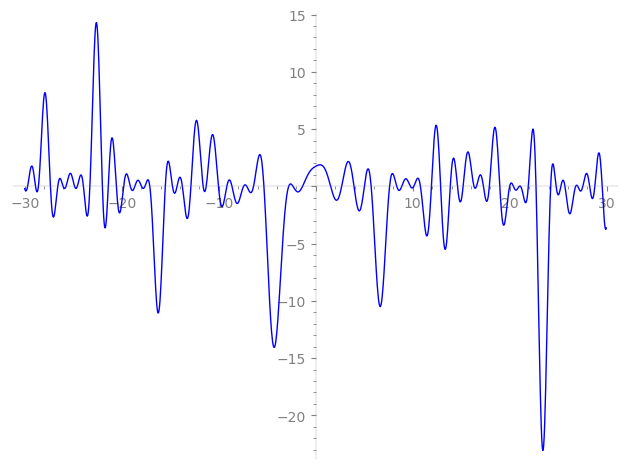| L(s) = 1 | + (−1.36 + 0.366i)2-s + (1.58 − 2.75i)3-s + (1.73 − i)4-s + (2.54 + 2.54i)5-s + (−1.16 + 4.34i)6-s + (2.55 + 0.684i)7-s + (−1.99 + 2i)8-s + (−3.55 − 6.15i)9-s + (−4.40 − 2.54i)10-s − 6.35i·12-s + (−2.47 + 2.62i)13-s − 3.74·14-s + (11.0 − 2.95i)15-s + (1.99 − 3.46i)16-s + (7.10 + 7.10i)18-s + (2.16 − 8.09i)19-s + ⋯ |
| L(s) = 1 | + (−0.965 + 0.258i)2-s + (0.917 − 1.58i)3-s + (0.866 − 0.5i)4-s + (1.13 + 1.13i)5-s + (−0.474 + 1.77i)6-s + (0.965 + 0.258i)7-s + (−0.707 + 0.707i)8-s + (−1.18 − 2.05i)9-s + (−1.39 − 0.803i)10-s − 1.83i·12-s + (−0.686 + 0.726i)13-s − 0.999·14-s + (2.84 − 0.763i)15-s + (0.499 − 0.866i)16-s + (1.67 + 1.67i)18-s + (0.497 − 1.85i)19-s + ⋯ |
\[\begin{aligned}\Lambda(s)=\mathstrut & 728 ^{s/2} \, \Gamma_{\C}(s) \, L(s)\cr =\mathstrut & (0.744 + 0.667i)\, \overline{\Lambda}(2-s) \end{aligned}\]
\[\begin{aligned}\Lambda(s)=\mathstrut & 728 ^{s/2} \, \Gamma_{\C}(s+1/2) \, L(s)\cr =\mathstrut & (0.744 + 0.667i)\, \overline{\Lambda}(1-s) \end{aligned}\]
Particular Values
| \(L(1)\) |
\(\approx\) |
\(1.63795 - 0.627010i\) |
| \(L(\frac12)\) |
\(\approx\) |
\(1.63795 - 0.627010i\) |
| \(L(\frac{3}{2})\) |
|
not available |
| \(L(1)\) |
|
not available |
\(L(s) = \displaystyle \prod_{p} F_p(p^{-s})^{-1} \)
| $p$ | $F_p(T)$ |
|---|
| bad | 2 | \( 1 + (1.36 - 0.366i)T \) |
| 7 | \( 1 + (-2.55 - 0.684i)T \) |
| 13 | \( 1 + (2.47 - 2.62i)T \) |
| good | 3 | \( 1 + (-1.58 + 2.75i)T + (-1.5 - 2.59i)T^{2} \) |
| 5 | \( 1 + (-2.54 - 2.54i)T + 5iT^{2} \) |
| 11 | \( 1 + (9.52 - 5.5i)T^{2} \) |
| 17 | \( 1 + (-8.5 + 14.7i)T^{2} \) |
| 19 | \( 1 + (-2.16 + 8.09i)T + (-16.4 - 9.5i)T^{2} \) |
| 23 | \( 1 + (-3.01 - 1.74i)T + (11.5 + 19.9i)T^{2} \) |
| 29 | \( 1 + (14.5 + 25.1i)T^{2} \) |
| 31 | \( 1 - 31iT^{2} \) |
| 37 | \( 1 + (32.0 - 18.5i)T^{2} \) |
| 41 | \( 1 + (-35.5 + 20.5i)T^{2} \) |
| 43 | \( 1 + (-21.5 + 37.2i)T^{2} \) |
| 47 | \( 1 + 47iT^{2} \) |
| 53 | \( 1 - 53T^{2} \) |
| 59 | \( 1 + (-14.4 - 3.87i)T + (51.0 + 29.5i)T^{2} \) |
| 61 | \( 1 + (4.96 + 8.60i)T + (-30.5 + 52.8i)T^{2} \) |
| 67 | \( 1 + (-58.0 + 33.5i)T^{2} \) |
| 71 | \( 1 + (4.29 - 16.0i)T + (-61.4 - 35.5i)T^{2} \) |
| 73 | \( 1 + 73iT^{2} \) |
| 79 | \( 1 + 15.7T + 79T^{2} \) |
| 83 | \( 1 + (5.83 + 5.83i)T + 83iT^{2} \) |
| 89 | \( 1 + (77.0 - 44.5i)T^{2} \) |
| 97 | \( 1 + (84.0 + 48.5i)T^{2} \) |
| show more | |
| show less | |
\(L(s) = \displaystyle\prod_p \ \prod_{j=1}^{2} (1 - \alpha_{j,p}\, p^{-s})^{-1}\)
Imaginary part of the first few zeros on the critical line
−10.02634695601645382301250650509, −9.164147736024421778064187222720, −8.630610948755975275779626878061, −7.43735204785136974315594070243, −7.10626886372557489434534998914, −6.41007958828631117245679803287, −5.33983130253776015781883696262, −2.78541262882005432903144923682, −2.33965303724404413388445460091, −1.35442331619770142722822551241,
1.53729074663556180885445615894, 2.67421396722663073100672536086, 3.94675682178564592466017008531, 5.01329836253012301226307612015, 5.71480774684928294112297340598, 7.61334575308745694989108051580, 8.351967576496078281274947748964, 8.868669712820572408927425831609, 9.758263056664282245944662444550, 10.10759189135407787364425426055

